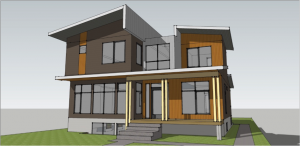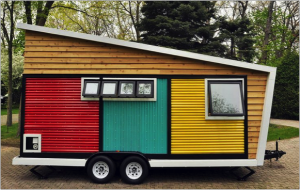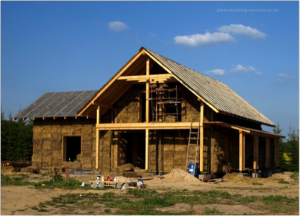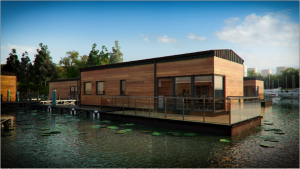The Rise of Eco-friendly Homes
 When you think about a typical house, it is usually made from either stone or brick, powered by electricity and has a roof structured to protect its residents from rain. However, as millennials hit the housing market, the criteria has begun to change and they are driving the construction of ‘wellness-minded’ buildings.
When you think about a typical house, it is usually made from either stone or brick, powered by electricity and has a roof structured to protect its residents from rain. However, as millennials hit the housing market, the criteria has begun to change and they are driving the construction of ‘wellness-minded’ buildings.
With solar panels in the roofs and built with environmentally friendly materials, green buildings have become popular not just amongst millennials, but with celebrities too. Orlando Bloom, Prince Charles and Damien Hurst, all have sustainable homes and the number continues to rise.
Let’s take a look at exactly why eco-friendly homes are on the rise.
But First, what is an Eco-friendly Home?
Developed to have a limited effect on the environment, eco-friendly homes are built to be as self-sufficient as possible. Using many natural resources such as light, wind and earth, sustainable homes aim to lower their carbon footprint and significantly reduce the amount of heat and power a homeowner consumes.
Economically insulated by incorporating earthbags, logs, stones, recyclables, bamboo and straw, eco-friendly homes cause significantly less damage to the surrounding environment. Other benefits include:
- Lower maintenance requirements
- Consistent temperature
- Higher quality air (and better health)
- Reduced waste
- Reduced expenses
Why Are They Growing in Popularity?
 Sustainability is a word that has been used more frequently over the years with reducing carbon emissions and saving the environment on the top of everyone’s agenda. This has caused several homeowners to relocate from traditional bricks-and-mortar houses into different types of accommodation.
Sustainability is a word that has been used more frequently over the years with reducing carbon emissions and saving the environment on the top of everyone’s agenda. This has caused several homeowners to relocate from traditional bricks-and-mortar houses into different types of accommodation.
Jo and Paul Morton, who live the ultimate ‘low impact’ lifestyle in a caravan, explain: “Everything we do is based on reducing our carbon footprint as far as possible. Whether bathing in harvested rain water or growing cabbages to preserve as sauerkraut for winter, we plan carefully so we minimise our use of fossil fuels.”
Taking to water, a lady who has lived on an eco-friendly narrowboat for six years, commented: “At the moment I recycle everything that I can. I don’t have solar panels but if our current weather is likely to be repeated in future summers I would definitely consider it. I also don’t really forage for food except the occasional blackberry.”
However, the changes in the way we live could mostly be down to ‘green’ millennials, i.e. those who were born at the beginning of the rise in interest in green attitudes and behaviour. According to a survey conducted by The Guardian, more than two thirds of millennials ‘buy as many eco-friendly products as they can’ and in a recent survey 66% of global respondents say that they’re willing to pay more for products and services which come from companies that are committed to a positive social and environmental impact.
Growing up in an eco-conscious society millennials are clearly more aware of their effect on the environment and are likely to be behind the rise in eco-friendly homes.
What is the Cost Benefit?
Eco-friendly homes can help you save time and money as the materials used are easily accessible. Many builders are able buy the materials locally, which not only saves time, but also reduces the carbon footprint by minimising the distance they need to be shipped. Furthermore, using recycled materials means a lower upfront cost and construction is often quicker – materials are more likely to be available and nearby.
It is not only cheaper to build a sustainable home, but the cost of day-to-day living is also reduced. Relying on renewable energy lowers operating costs and can end up reducing the monthly bills by up to 20%-30%. Saving this much a month will make a big difference to the home owner financially and there are many more cost benefits that can be explored.
Eco-friendly homes require less maintenance as they are constructed to last a long time. Less money is spent making repairs or applying touch ups because green materials are durable and look new for longer. The buildings’ extended lifespan will also lead to a higher property value so if the homeowner decides to sell they would increase their initial investment.
Additionally, there are many tax incentives when buying an eco-friendly home. Barclays Bank has recently launched ‘green’ home mortgages which reward buyers with a lower mortgage rate on certain deals when you buy an energy efficient home. Other incentives have been put forward, such as VAT dropping to 5% for certain home energy-saving products and some households that use renewable technology to generate electricity don’t have to pay income tax on the Feed-in-Tariff (FIT) payments they receive.
The Different Types of Eco-Friendly Homes Available
 Not all green buildings are the same and vary due to climatic conditions and environmental issues. Eco-friendly homes differ across the globe and are often built with the new owner’s requirements and desires in mind.
Not all green buildings are the same and vary due to climatic conditions and environmental issues. Eco-friendly homes differ across the globe and are often built with the new owner’s requirements and desires in mind.
The sustainable homes currently available include:
- Tiny builds – usually between 100 and 400 square feet
- Prefabs (prefabricated homes) – manufactured in parts ahead of time and off site
- Passive house – built using rigorous standards for energy efficiency
- Straw bale – straw is used for insulation or as an actual structural component
- Zero carbon – extremely efficient and it has no annual net carbon footprint
- Earthships – constructed with natural and recycled materials, they are completely self-sustaining
- Rammed earth – built from tightly packed soil
- Shipping container – steel cargo containers are used as a structural element
 All builds are shaped for their approach to green living and Jeff Whyatt, Managing Director of BWML, says: “BWML have a number of marinas across the UK. The sole ethos for Sawley Marina has been to construct beautiful ethical floating homes that enhance the countryside and deliver a very low carbon footprint, low energy bills and a conscientious lifestyle that is only dreamed of by land dwellers.”
All builds are shaped for their approach to green living and Jeff Whyatt, Managing Director of BWML, says: “BWML have a number of marinas across the UK. The sole ethos for Sawley Marina has been to construct beautiful ethical floating homes that enhance the countryside and deliver a very low carbon footprint, low energy bills and a conscientious lifestyle that is only dreamed of by land dwellers.”
Are Economic Homes the Future?
The Guardian reveals that over the last few year’s campaigners has been asking the Government to guide the country into becoming more aware of societies environmental impact which in turn has led to the ban of plastic bags, microbeads, plastic straws and drink stirrers.
By 2030 the European Commission want to ensure that 55% of all plastic is recycled and results from global business leader in market research IBISWorld (see chart above) shows that public concern over environmental issues has been extrapolated to continue to grow.
This data suggests that interest in economic homes is going continue to rise, and one narrowboat owner believes the increased interest could do wonders for the environment: “I think it is great to strive for eco-friendly homes and boats. I would feel I was contributing towards energy saving as well as it benefitting me personally by keeping my energy costs down”.
In the future it is thought that both home owners and businesses will be looking into green buildings. A new breed of eco-farmhouses has already been introduced in Wales and it is likely that more operations will follow suit. Additionally, with more resources being introduced every day, eco-friendly homes will become even more accessible at a lower cost; meaning they are likely to continue to rise in popularity.
Are you concerned about the impact we have on the environment and wonder what you can do to help? From recycling and re-using plastics, to using only eco-friendly products and living a low carbon lifestyle, we want to hear from you!


Sorry, the comment form is closed at this time.